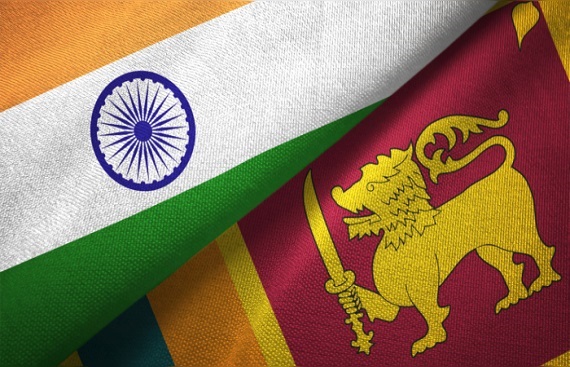How India is assisting Sri Lanka to cope with economic crisis

Lately, Sri Lanka, the island nation of 22 million people, has been facing a crisis owing to a severe Balance of Payments (BoP) problem. A severe shortage of foreign currency has left the Sri Lankan government unable to pay for essential imports, including fuel, leading to debilitating power cuts for hours. The foreign exchange reserves are rapidly depleting, and becoming more difficult for the country to import basic consumption goods. After the country steeply devalued its currency last month ahead of the discussion with the International Monetary Fund (IMF) for a loan programme, the public is dealing with shortages and soaring inflation.
As per critics, the historical imbalances in the Sri Lankan economic structure, the International Monetary Fund (IMF)’s loan-related conditionalities, and the misguided policies of authoritarian rulers are the reasons for the present economic crisis.
“Sri Lanka is a classic twin deficits economy,” stated a 2019 Asian Development Bank working paper. “Twin deficits signal that a country’s national expenditure exceeds its national income, and that its production of tradable goods and services is inadequate.”
Why Sri Lanka is suffering from the Crisis
![]()
The present crisis was accelerated by deep tax cuts, enacted months before the pandemic, which wiped out parts of Sri Lanka’s economy. With the country’s beneficial tourism industry and foreign workers’ allowances worn out by the pandemic, credit rating agencies moved to demote Sri Lanka and effectively locked it out of international capital markets. Consequently, Sri Lanka’s debt management programme, which depended on accessing those markets, was ruined, and foreign exchange reserves plummeted by almost 70 percent in two years. Additionally, restriction on all chemical fertilizers in 2021 has hit the country’s farm segment and triggered a drop in the critical rice crop.
Along with the short-term indecency of the Sri Lankan government, China’s heavy investment and its influence on Sri Lanka to take on more debt to build non-economically viable infrastructure projects have also led the nation to the crisis. Between 2012-2016 China accounted for 30% of all Foreign Direct Investment into Sri Lanka. Chinese loans and equity are funding an estimated 50 major and minor projects in the country worth $11 billion. Not only large-scale projects like Hambantota Port and Colombo Port City but also roads and water treatment plants.
Chinese loans also reach a much higher interest rate (6.5% per annum) than the Asian Development Bank (2.5%-3% per annum). In 2017, the Sri Lankan government paid 83% of its revenue on debt repayment. The crushing external debt of the nation is one of the leading causes of its current economic crisis. It has forced the country to repeatedly devalue its currency only to be able to buy food for its people.
India, an assisting hand to Sri Lanka
![]()
Since January 2022, India has been equipping crucial economic support to the island nation in the grip of a severe dollar crisis that, many fear, might lead to a sovereign default and an intense shortage of necessities in the import-reliant country. India extended the relief from the beginning of 2022, totaling over USD 1.4 billion - a USD 400 currency swap, a USD 500 loan deferment, and a USD 500 Line of Credit for fuel imports. More lately, India raised a USD 1 billion short-term concessional loan to Sri Lanka to assist the country as it faces an unusual economic crisis.
Significantly, any disillusionment in Sri Lanka with China relieves India’s effort to keep the Lankan archipelago out of China’s ‘string of pearls’ game in the Indo-Pacific. Indeed, it is in India’s interest to contain the Chinese presence and influence in this region. To the extent India can expand low-cost assistance to lessen the hardships of Sri Lankans, it should, yet, it must be done with expected care, keeping in mind that the optics of its support matters too.
Possible ways of recovery forward
![]()
The Sri Lankan government should take measures for the country's economic recovery as soon as the shortage of certain essential commodities concludes, anticipated before the beginning of the Sinhala-Tamil New Year (in mid-April).
The government should also collaborate with the Tamil political leadership to devise a roadmap for the economic development of the war-affected northern and eastern provinces, among the areas badly affected by the current crisis. It might raise domestic tax revenue and shrink government expenditure to restrict borrowing, particularly sovereign borrowing from external sources.
Stern measures should be taken for reforming the administration of concessions and subsidies. India must proffer Sri Lanka financial support, policy advice, and investment from Indian entrepreneurs. Indian businesses must set up supply chains that intertwine the Indian and Sri Lankan economies in goods and services ranging from tea export to information technology services. Rather than any other nation, India should help steer Sri Lanka towards realizing its potential to reap the rewards of a stable, friendly neighborhood.
Neither Sri Lanka nor India can afford to have strained relations. As a much larger country, the onus is on India, and it requires being incredibly patient and engaging Sri Lanka even more regularly and closely. There is also a requirement to step up our people-centric developmental activities while scrupulously clear of any interference in Colombo’s domestic affairs.
